Disclaimer: The Armytek Prime C2 Pro was provided for testing by the manufacturer free of charge
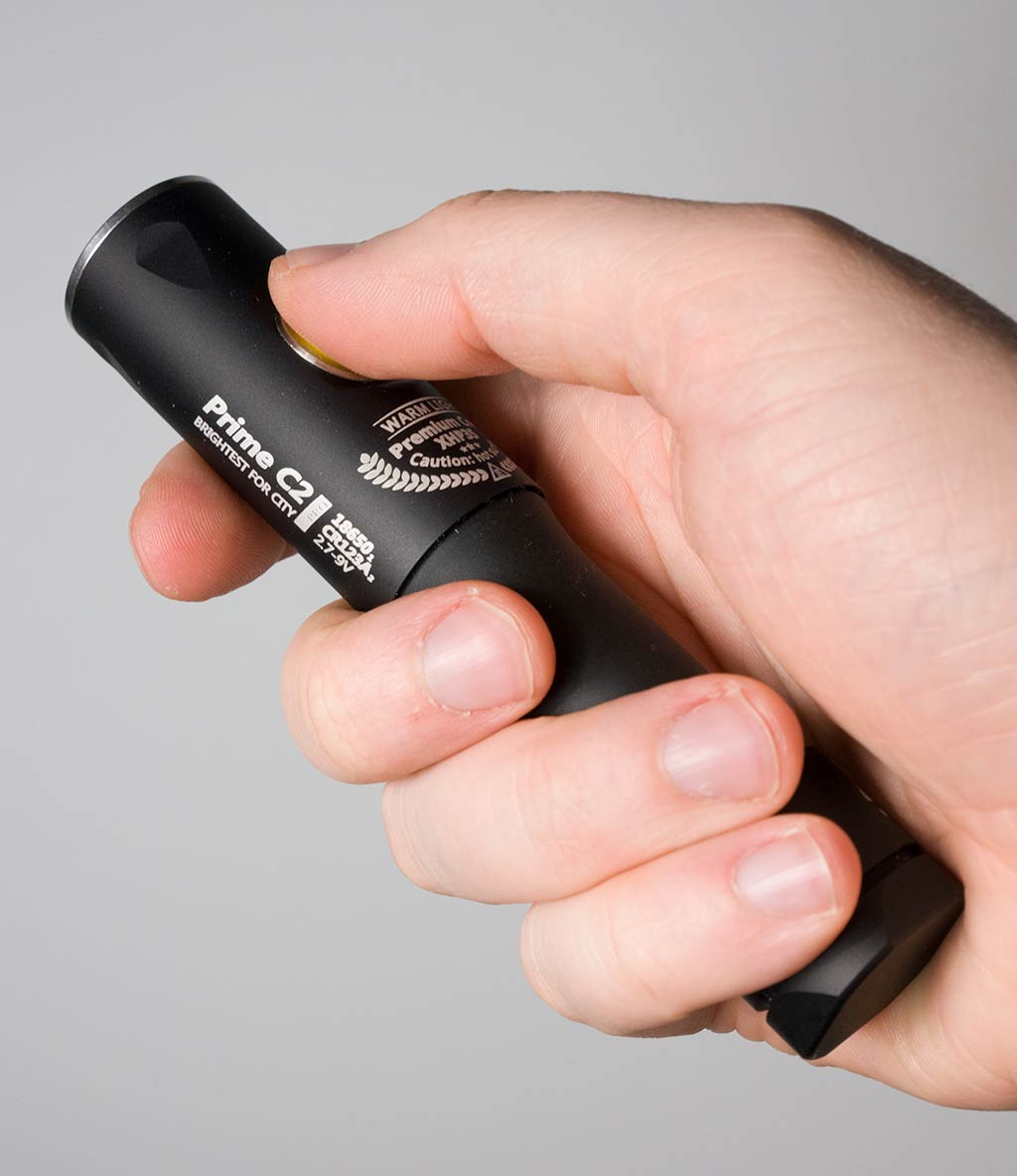
Features and manufacturer's specifications
Battery: 18650, 2x CR123A, 2x RCR123/16340, 2x 18350
Input voltage: 2.7-9 V
LED: Cree XHP35 HD, available in warm (tested) and "white"
Waterproof: IP68, 10 meters, 2 hours
Impact resistance: 10 meters
Mode memory: yes
Manufacturer's output specs
Maximum output: 1581 lumens
Other output levels: 884/391/167/33/6/1.6/0.14 lumens
Beam distance: 185 m
Light intensity: 8571 candela (calculated from beam distance)
Measured dimensions and weight
Length: 123.4 mm
Head width: 24.5 mm
Handle width: 20.4 mm
Weight: 64 g for the light and 47 g for an 18650 battery
More info on the manufacturer's product page
Box and contents
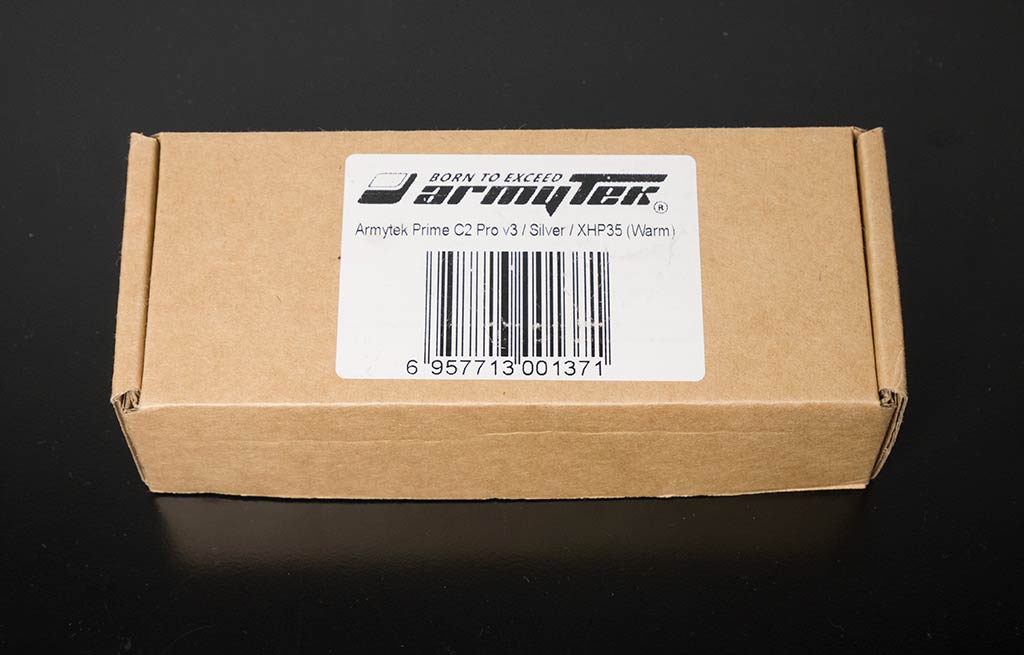
The light is packaged in a plain brown box.
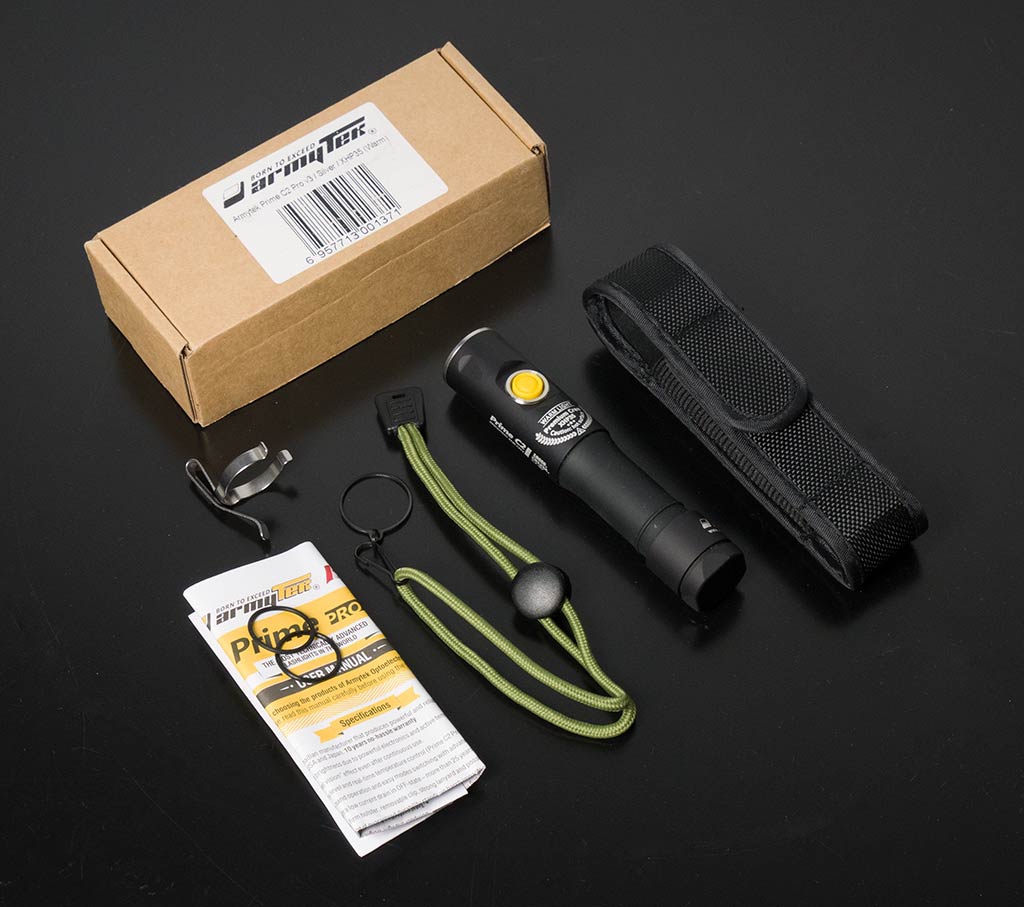
Bundled in the box with the light:
Holster
Lanyard
Pocket clip
Two spare o-rings
User manual
Between all the included retaining options and the magnetic tailcap, there's a multitude of ways to carry the Prime C2. The pocket clip could be a bit longer though.
User interface
The Prime C2 Pro is controlled by a single side switch.
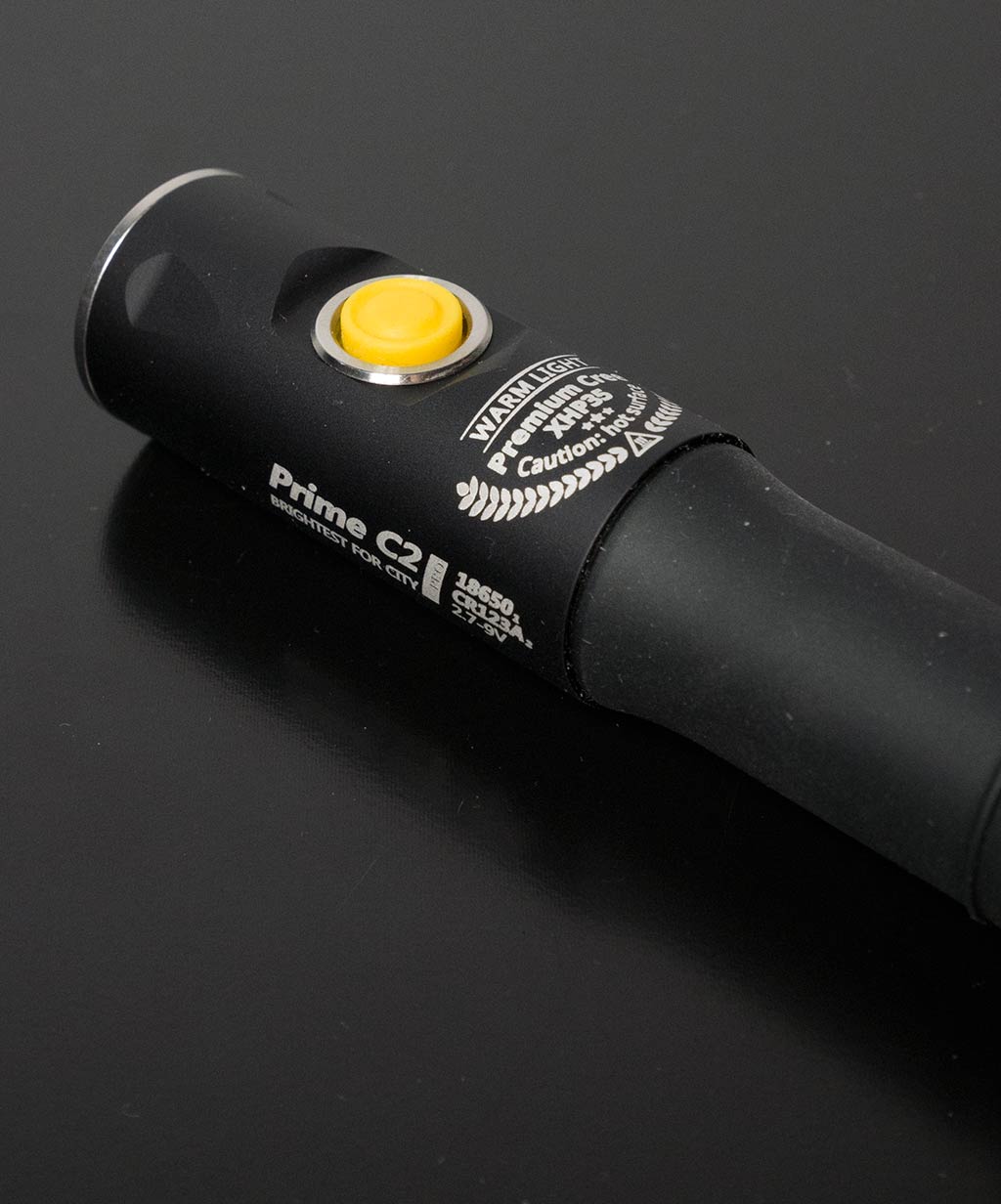
The button is excellent and has a distinct click to it. Double and triple clicks are no problem unlike on some mushy switches. There's a backlight on the button. Three yellow flashes in succession every two seconds means that the light is running warm, three red flashes repeated every second means it is getting too hot (60°C claimed, 70°C tested) and will lower the output to protect the emitter and battery. The output will increase again if the light is cooled down as long as the battery is still up to the task.
The button light will flash every five seconds while the light is on. By default this behavior is disabled on firefly modes, but can be enabled. The color of the flash will indicate if the battery is almost full (green) or under 75% (yellow). When the battery voltage gets low, the flashes are yellow (<25%) and finally red (<10%). These can be distinguished from the heat warning because they occur once every two (yellow) or one second (red), not with triple flashes. If instead of a single 18650 you are using two CR123A, RCR123/16340 or 18350 batteries, you can adjust the voltage indicator from three options from a special menu.
There are seven brightness levels in total which are grouped into three sets:
Three firefly modes
Three main modes
Two turbo modes
Three special modes: strobe, beacon high, beacon low
Operation is as follows
From off:
Single click turns the light on on previously used brightness (includes strobe and beacon modes)
Double click turns the light on on main mode group (sub mode is memorized)
Triple click turns the light on on turbo mode group (sub mode is memorized)
Quad click turns the light on on special mode group (strobe, low beacon, high beacon)
Press and hold cycles the modes from the lowest upwards all the way to turbo 1, release to select mode
From on:
Single click turns the light off
Double click switches from main to firefly or from firefly to main or from turbo/special to main
Triple click switches to turbo modes
Quad click switches to special modes
If any of the turbo or special modes was used previously, a double click from off flashes briefly that mode before settling on the main mode group. This isn't a big problem even at night as you can always hold the switch down and start cycling the modes from the lowest firefly mode.
There's two operational modes, general and tactical. The default mode is the general, which corresponds to the UI described above. In tactical mode the switch is momentary with mode memory. The light will be on only when the switch is pressed down. Changing modes is not possible in the tactical mode.
To access tactical mode unscrew the tailcap to 1/4, press the switch and tighten the tailcap again keeping the button pressed. To return to the general mode press the button and while keeping it pressed unscrew the tailcap to 1/4.
You can break the circuit completely and lock out the light by screwing the tailcap open a bit. There's no electronic lockout, so this is useful when you put the light in your pocket or in a bag. However, the switch is nice and stiff and I didn't have any accidental activations even without physically locking the light out.
Physical appearance
The emitter is well protected deep inside the head under a glass lens and an optic. The steel bezel isn't glued but needs a tight grip to open and might prove difficult without proper tools. I used two rubber strap wrenches.
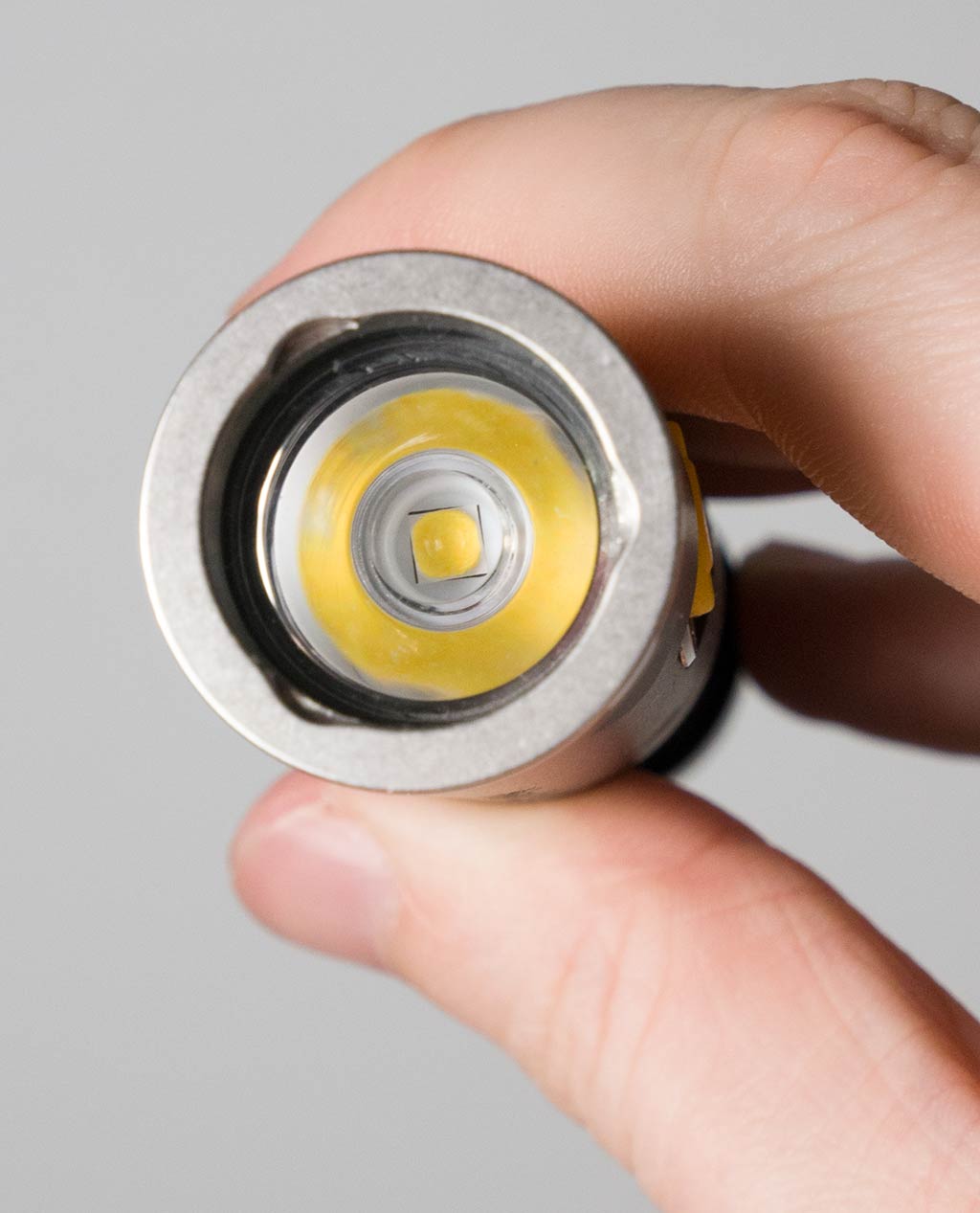

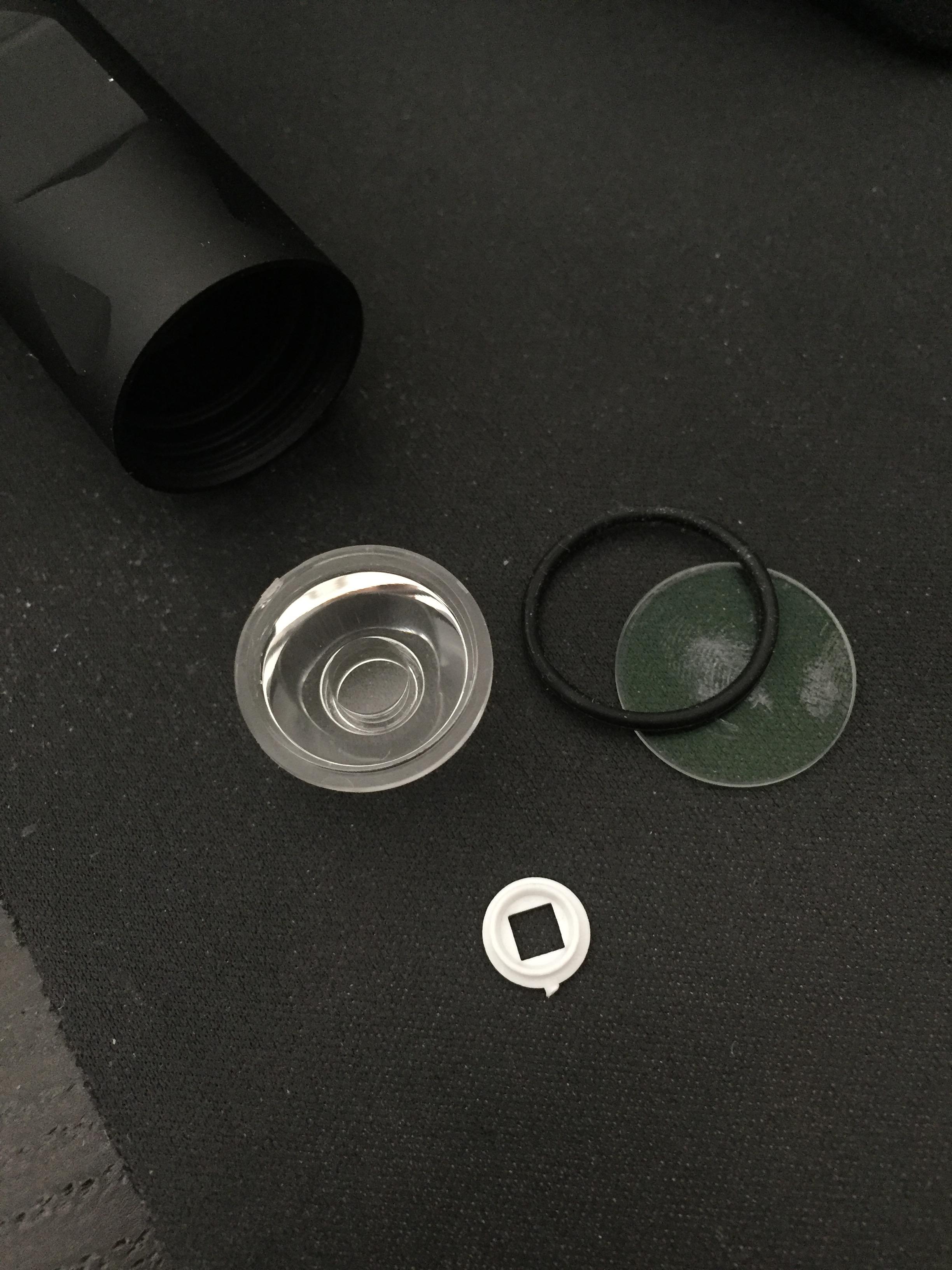
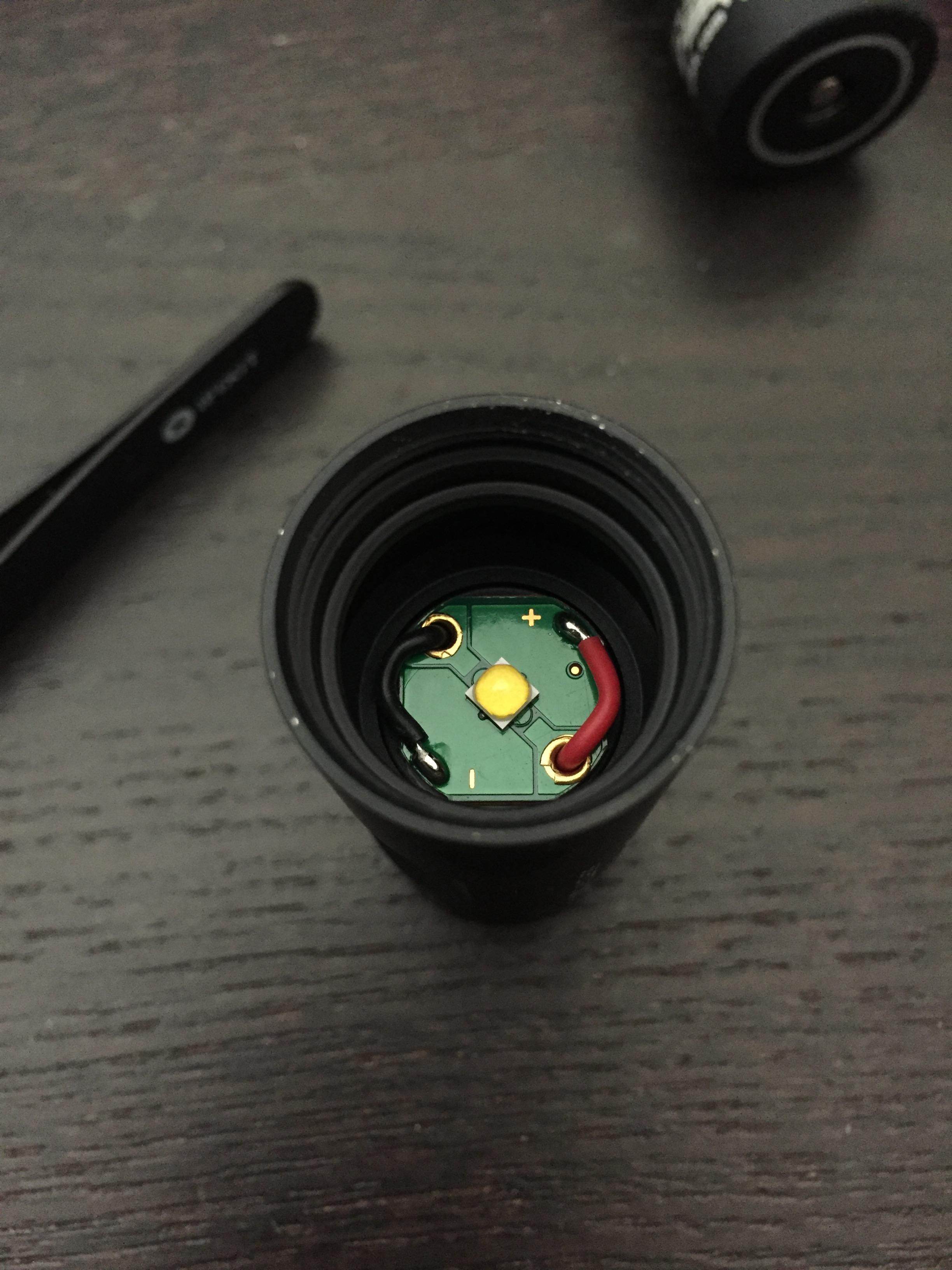
At the well machined threads the body is thicker than on the middle.
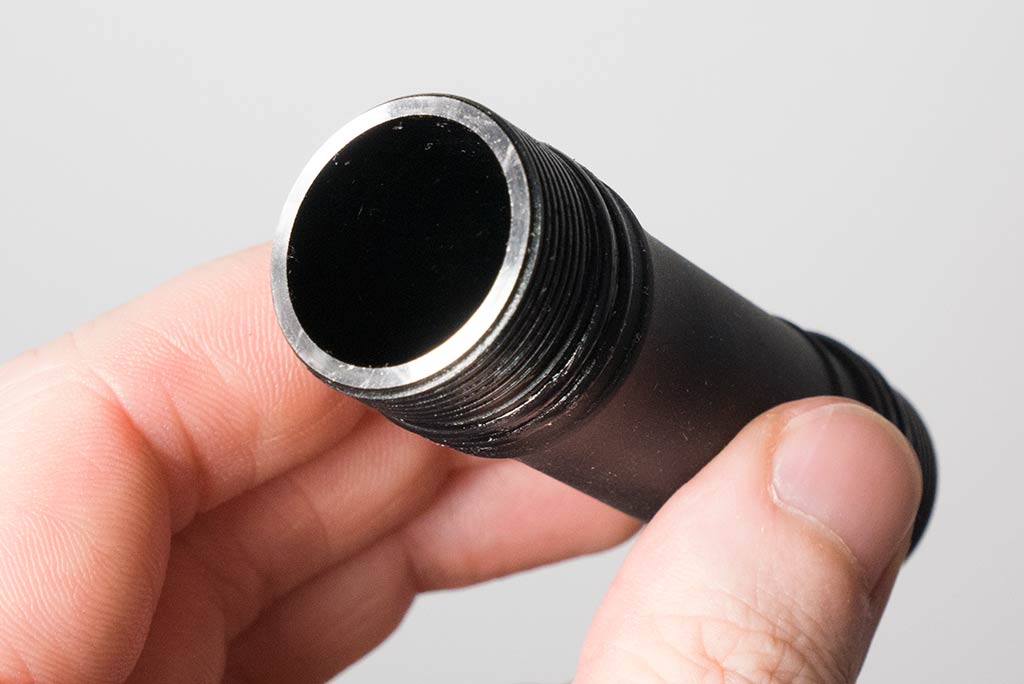
The tailcap splits into two parts and hides the strong but easily removable magnet.
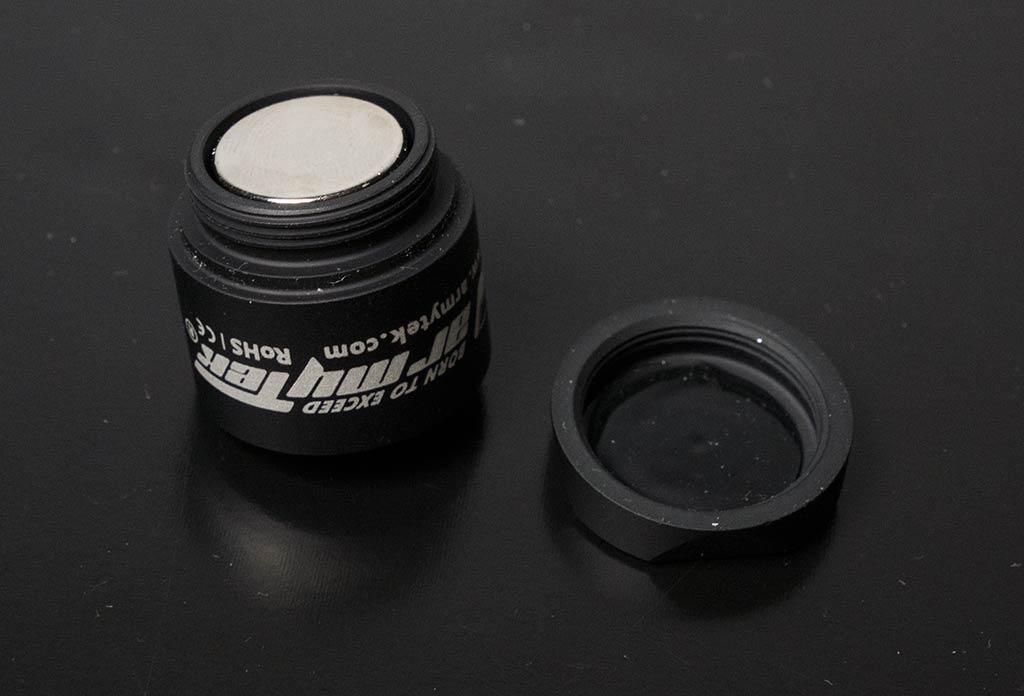
All battery types are compatible thanks to the protruding button on the driver. The long spring has a long travel for longer batteries. Armytek recommends batteries with at least 7 amp capability. Some protection circuits may not be able to go that high.
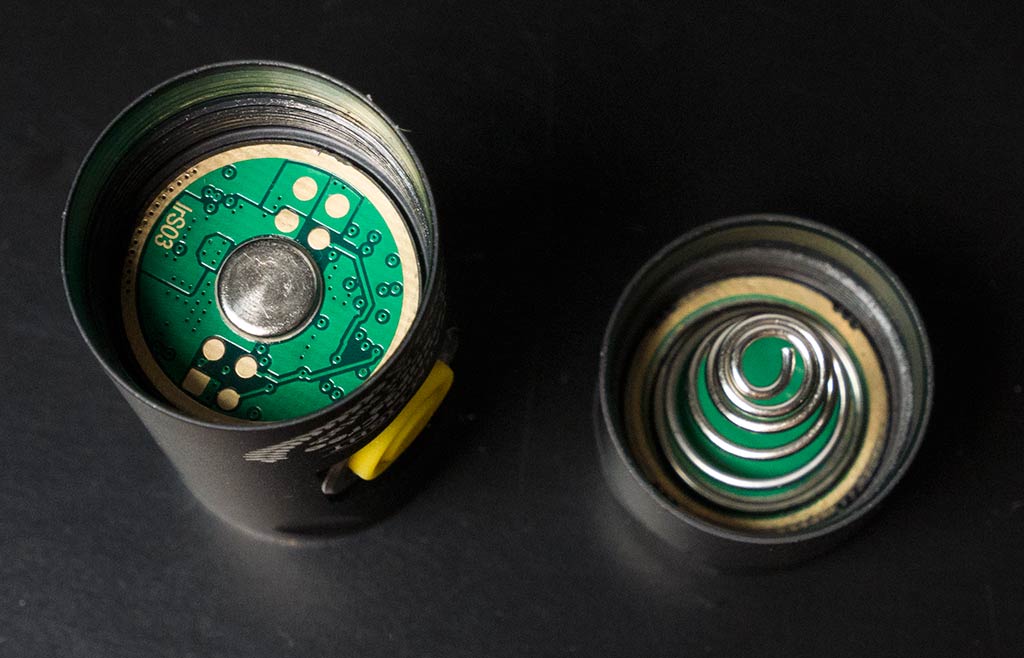
Size comparison
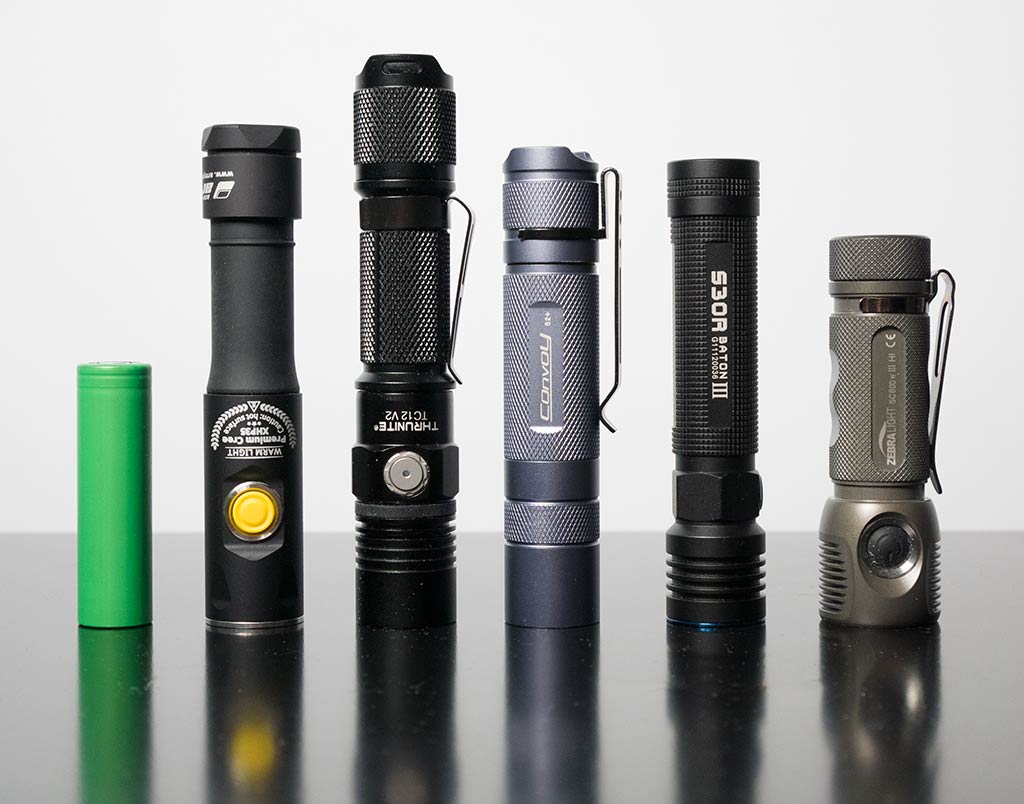
18650 battery, Armytek Prime C2 Pro, Thrunite TC12 V2, Convoy S2+, Olight S30R III, Zebralight SC600w Mk3 HI.
The Prime C2 is slim but quite long. It still fits inside jeans pocket without a problem.
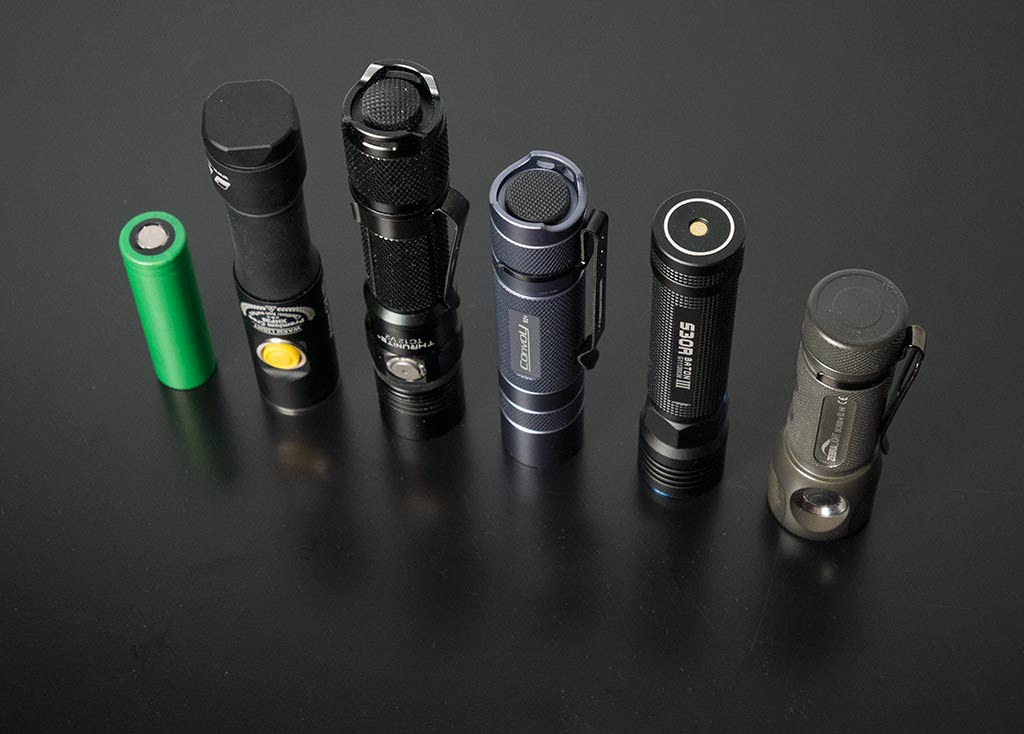
Beamshots
Finnish summer is here and sufficient darkness is limited to between midnight and 3 am. I'll post some outdoor beamshot comparisons as soon as possible.
Beam, tint and color rendering
For a domed multiemitter Cree, the tint is very consistent throughout the beam. Only the corona around the hotspot is just a tiny bit different.
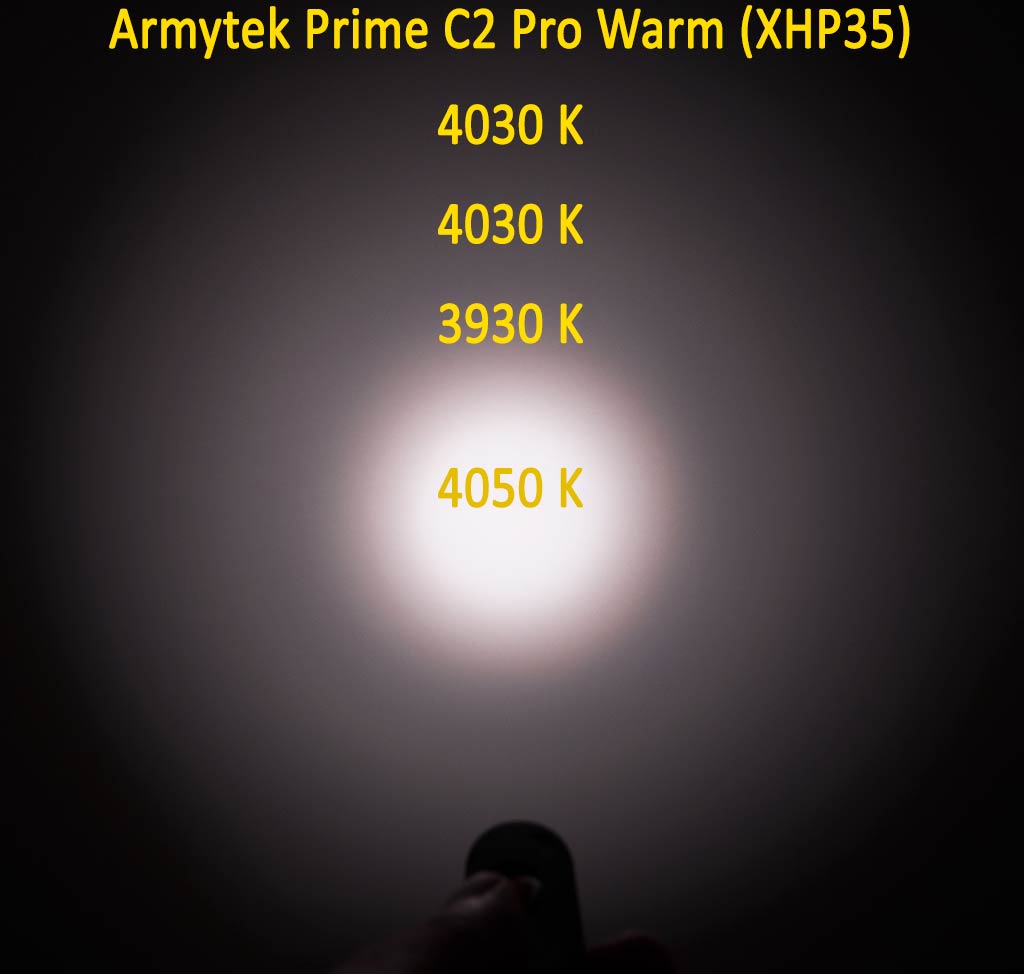
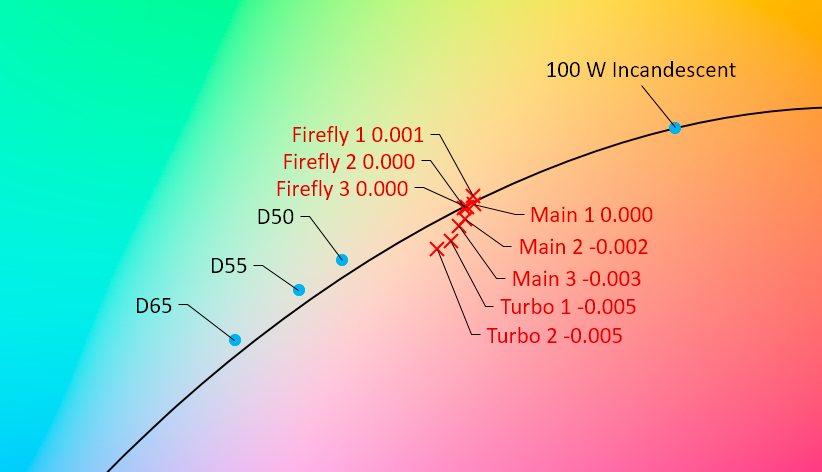
Tint in different brightness modes. As is usually the case there's some shift when the current is increased. Tint is skewed towards pink especially on the higher modes.
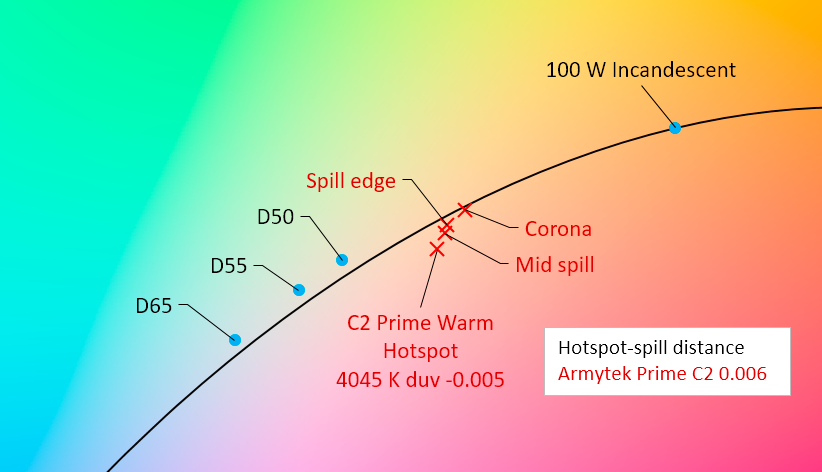
Tint in different parts of the beam with the corresponding duv values (distance from a neutral black body radiator, positive number means green/yellow tint, negative rosy/magenta/pink).
Spectral data and color rendering
For spectral information and CRI calculations I use an X-rite i1Pro spectrophotometer with HCFR, Babelcolor CT&A and ArgyllCMS spotread for the graphs and data. For runtime tests I use spotread with a custom script and an i1Display Pro because it doesn't require calibration every 30 minutes like the i1Pro.
Explanation of abbreviations (click link to read more)
CCT = correlated color temperature, higher temperature means cooler (bluish)
CRI (Ra) = color rendering index consisting of 8 different colors (R1-R8), max value 100
CRI (R9) = color rendering index with deep red, usually difficult for led based light sources, max value 100
TLCI = television lighting consistency index, max value 100
CQS (Qa) = Proposed replacement for CRI, RMS average of 15 color samples
CRI2012 (Ra,2012) = Another proposed replacement for CRI, consists of 17 color samples
MCRI = Color rendering index based on the memory of colors or 9 familiar objects
NEW Read more about the IES TM-30-15 method here (link is external)
TM-30 = The newest color rendering method using 99 samples. Preferred for comparing LEDs.
TM-30 (Rf) = Accuracy of colors, fidelity index. Replaces CRI(Ra).
TM-30 (Rg) = Gamut of colors, saturation index. Higher number means more saturated colors.
Tint dev. ("Duv" in the CTA screenshots) is the tint's distance to the black body radiator line in the CIE graphs. The higher the number, the greener the tint. 0,0000 means absolutely neutral white and negative numbers mean rosy/magenta tint. Anything over 0,0100 can be described as visibly green.
If you have an hour to spare, I recommend watching this presentation on IES TM-30-15 which also shines light into color rendering in general.
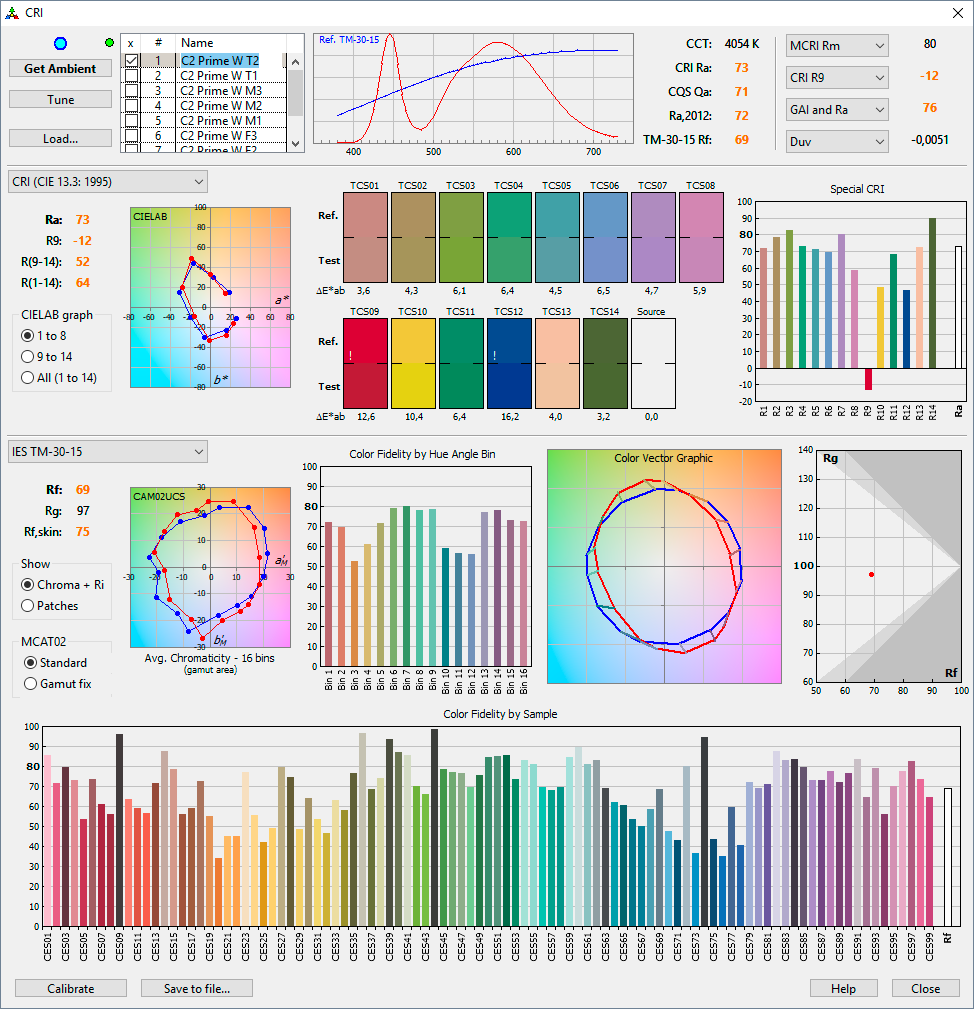
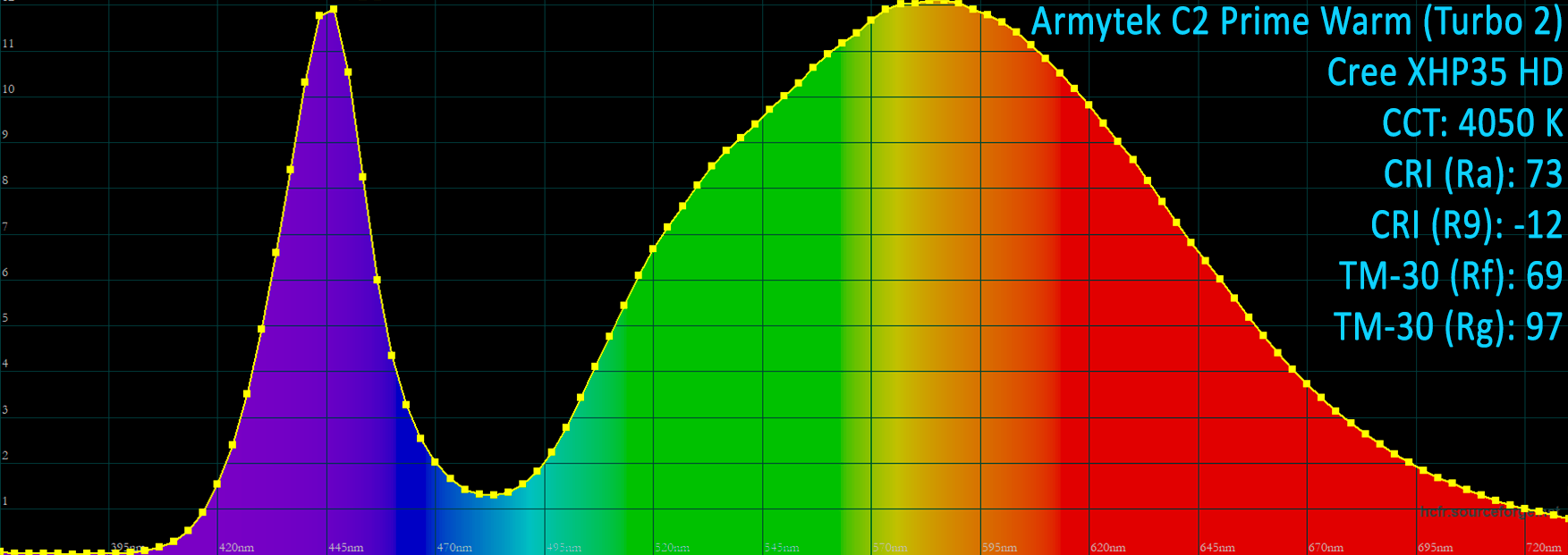

Runtimes and output

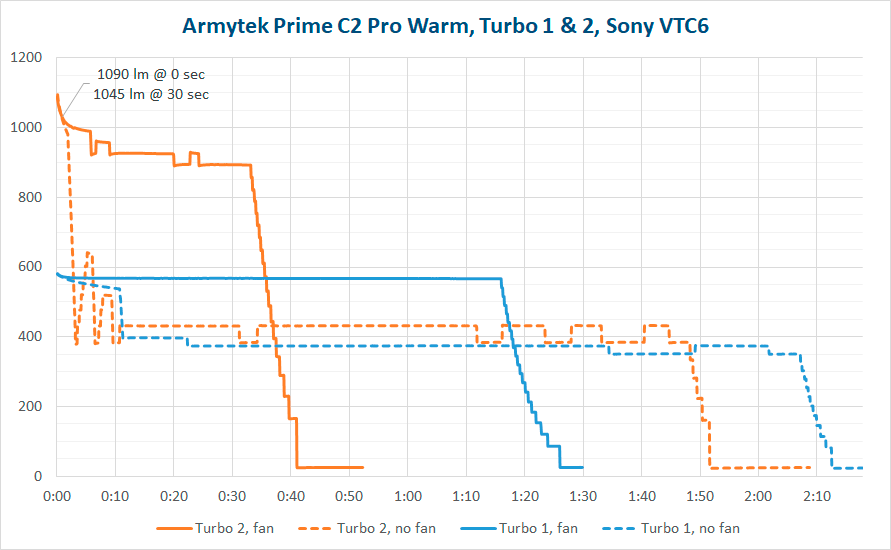
You can witness the thermal regulation doing its work by decreasing output when the light gets too hot and increasing after cooling. With serious cooling the light doesn't step down as tested by Zak Wilson.
All the modes end up at about 25 lumens and run for a long while. When I removed the batteries after a while at 25 lm, it read between 2.8 and 3.0 volts. According to Armytek and other reviewers there's also low voltage protection if you happen to forget the light on without supervision.
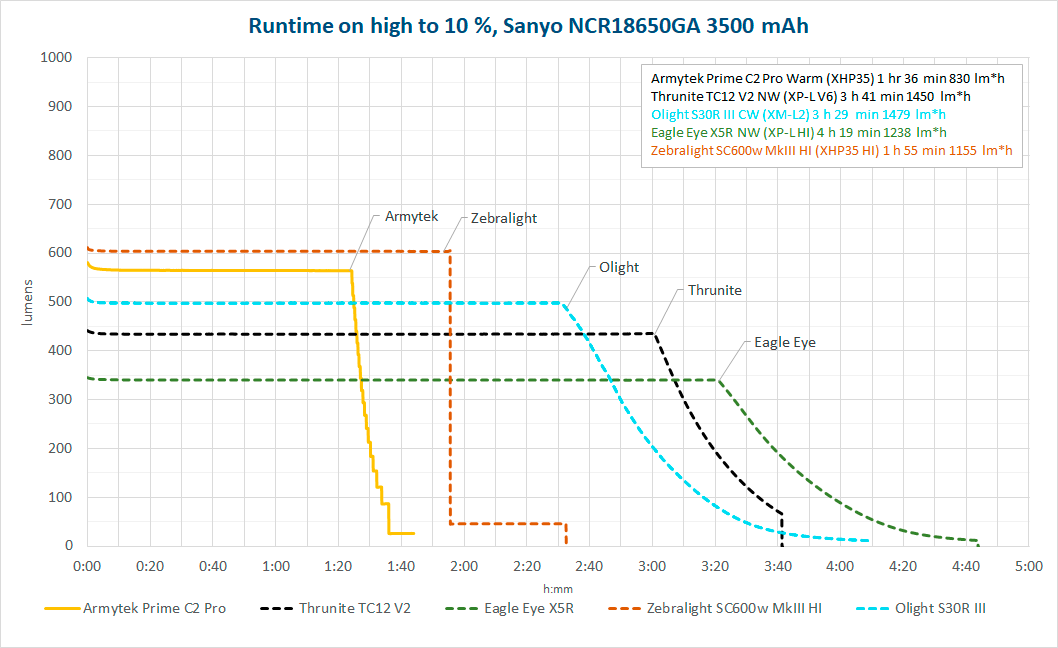

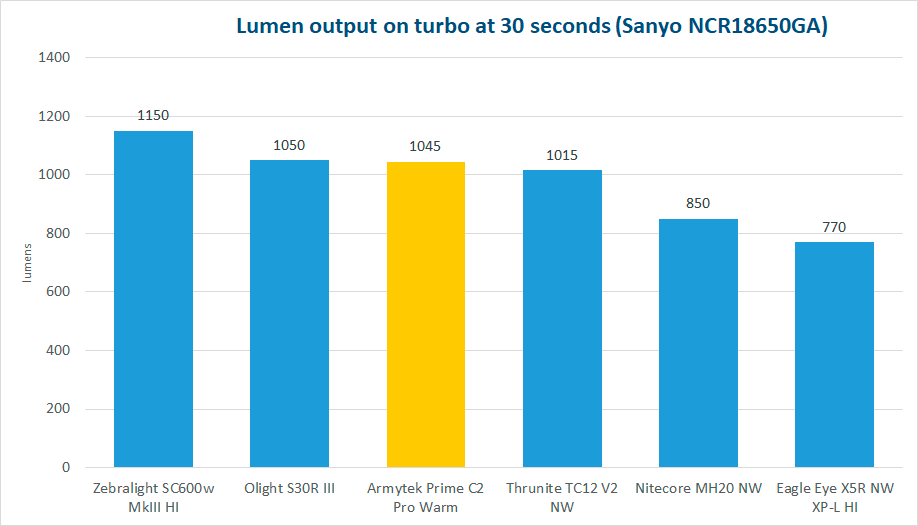
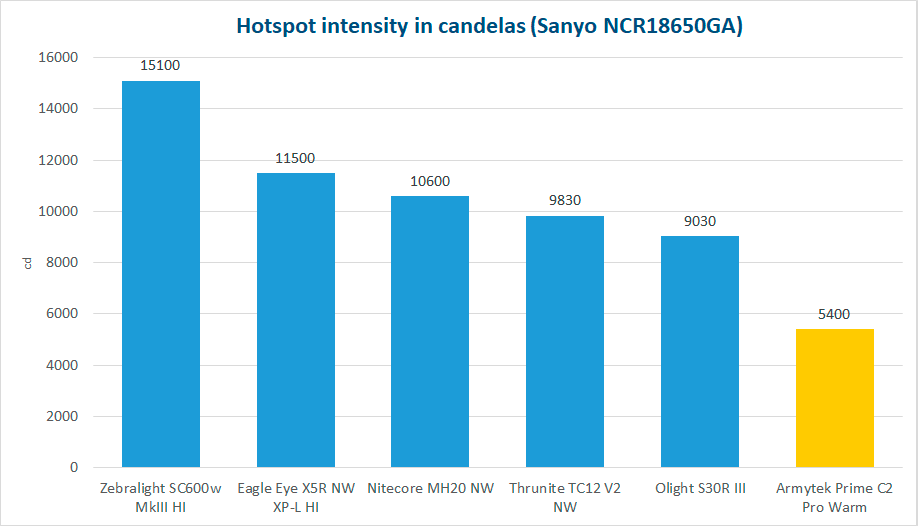
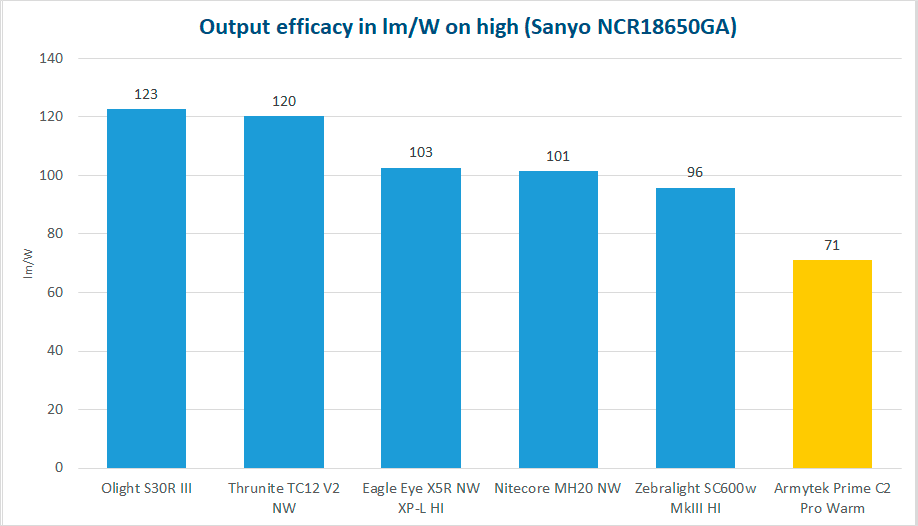
I had to check and recheck my numbers in three different spheres and also resorting to ceiling bounce, but there's no way around it: there's significant discrepancy between the output claims and what I measured.
I got about 33 percent less lumens and intensity than Armytek claims, which is a lot. Not very visible, but certainly significant. The boost driver works very well and I got the same maximum output with many different 18650 batteries. On lower performance (higher internal resistance) batteries the maximum output can't be sustained as long though.
Big part of the energy turns to heat, so the total output over time (lumen*hours) is lower than on the competitors I tested. Efficacy (lumens/watt) is 26 % worse than on the Zebralight SC600w Mk3 HI that also uses an XHP35 and a boost driver but has a higher CRI emitter.
Still, the maximum output does match the competitions, albeit with shorter runtimes and more heat. Also, the lowest firefly mode is truly dim.
Temperature
The Prime C2 Pro gets hot very fast on max output. It reaches 70 degrees celsius in under 3 minutes and starts throttling output. On the second highest mode (turbo 1), reaching the throttling temperature takes about 10 minutes. Temperature is high for 575 lumens.
Here are three 18650 lights measured with a thermal camera at 30 seconds and 2 minutes 30 seconds. The Armytek heats up significantly faster than the Zebralight or Olight with similar output. Please note though, that the Zebralight and Olight have already reduced their output before the 2:30 mark, so they are obviously running cooler.
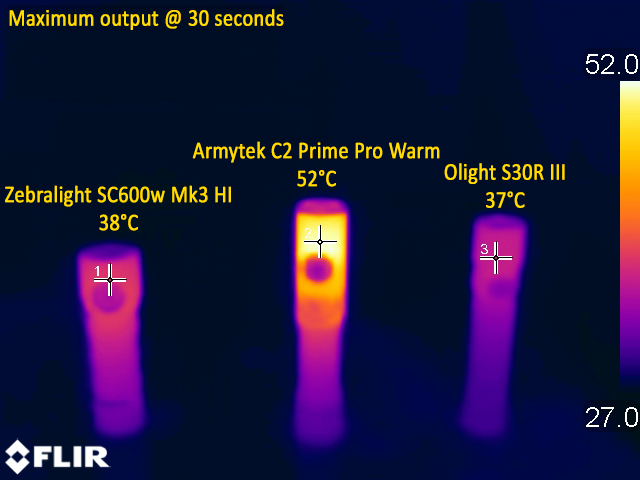
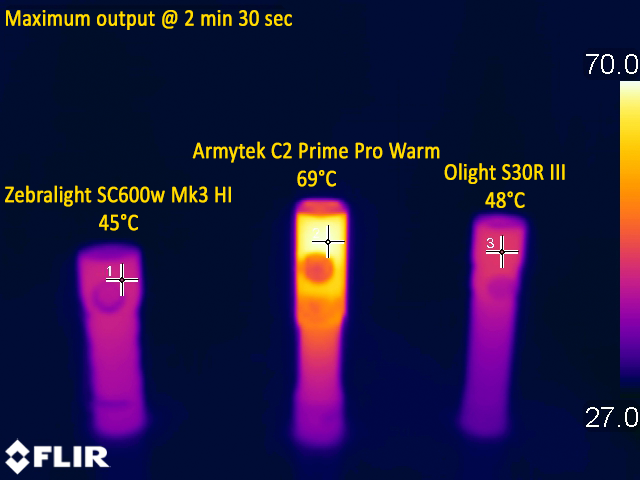
Here's the output comparison between the Armytek and Zebralight on max brightness without cooling. The slight rise in output on the Zebra is because I opened a window in the room.
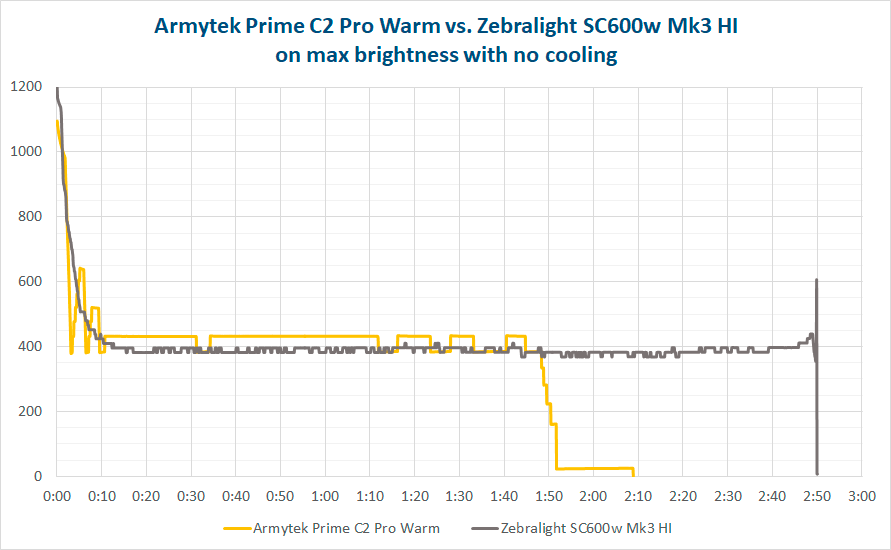
PWM
There's no PWM on any mode.
I did notice some intermittent noise on one of the firefly levels (forgot which).
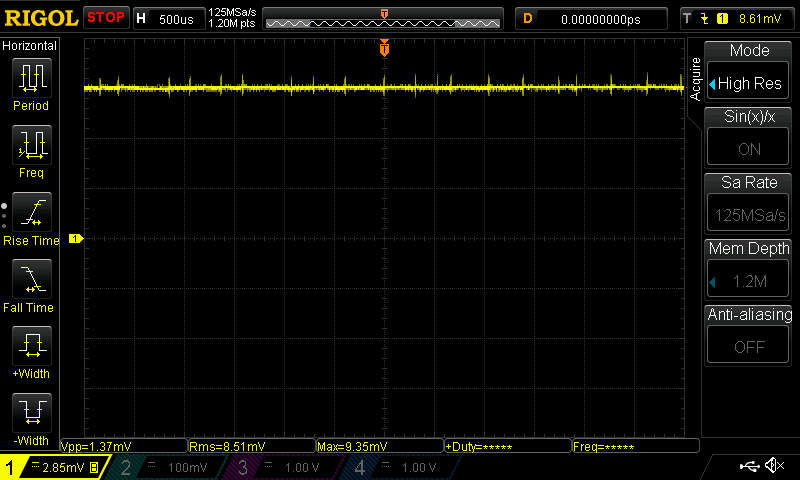
There's also some noise (audible and optical) whenever the side switch led flashes. Here it is coinciding with a short beacon flash. Neither of these are visible.
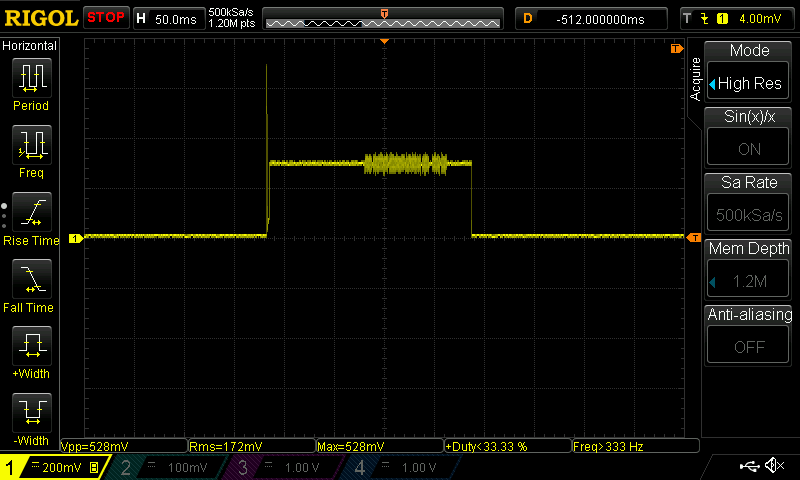
Standby current
As the switch is electronic, there is a small current being drawn from the battery even when the light is not turned on. I measured the parasitic standby drain at 7 µA. This means it would takes tens of years to drain a 18650, but of course the battery's self discharge rate is faster.
Verdict
Even though the Prime C2 Pro doesn't have as flashy a packaging as Armytek's headlamps, the product itself is convincing. The matte finish feels special and makes for a grippy surface without aggressive knurling. The light is truly a joy to handle. There's plenty of lubrication on the well machined and thick threads. Overall quality of the flashlight is excellent.
The electronic side switch has a good tactile click to it and after a while, the user interface will grow on you. There's instant access to all the three main mode groups (firefly, main, turbo) as well as mode memory. There is some quiet inductor whine from the boost driver, which doesn't bother me at all. However with a full battery I can hear distinct noise when the button light flashes.
My sample falls about a third short of the manufacturer's output claims (in luminous flux as well as intensity). 1581 vs. 1045 lumens and 8742 vs. 5400 cd. The light does get hot and steps down even on the lower of the turbo modes without active cooling. This makes for a mediocre efficacy (runtime for the lumens it puts out). Efficacy is significantly better on the main modes though.
The tint has a noticeably pinkish hue especially on the higher modes. My sample doesn't seem to be an exception, since other reviewers have also reported this. I do prefer this to green though, especially since it is not very obvious in real life use on main or firefly modes. There's a minuscule amount of yellowish hotspot artifacts due to the quad die emitter, but this is only visible on a white wall. That's also true for the one barely visible ring on the beam.
+ Excellent finish and build quality
+ Slim form factor (albeit quite long)
+ Great tactile feel of the switch
+ Instant access to all main mode groups, including firefly and special modes
+ True firefly modes
+ Very low standby drain
+ Real thermal control with a two stage warning light on the switch (yellow - red)
+ No timed stepdowns, flat regulation as long as the light is cooled adequately and the battery is up to it
+ Comes with a holster, lanyard, pocket clip and magnetic tailcap
+ Lens and optics are well protected deep in the head
+ Waterproofing and impact resistance (not tested)
- Lower than average efficacy (lumens per watt)
- Gets hotter faster than other 1000 lumen lights (this would be a good thing and an indication of good thermal path if the driver was also more efficient)
- Falls 33% short of manufacturer's output claims
- Strong pink tint on the higher modes (still better than green)
- Chirping noise from the blinking side switch with fresh batteries

Features and manufacturer's specifications
Battery: 18650, 2x CR123A, 2x RCR123/16340, 2x 18350
Input voltage: 2.7-9 V
LED: Cree XHP35 HD, available in warm (tested) and "white"
Waterproof: IP68, 10 meters, 2 hours
Impact resistance: 10 meters
Mode memory: yes
Manufacturer's output specs
Maximum output: 1581 lumens
Other output levels: 884/391/167/33/6/1.6/0.14 lumens
Beam distance: 185 m
Light intensity: 8571 candela (calculated from beam distance)
Measured dimensions and weight
Length: 123.4 mm
Head width: 24.5 mm
Handle width: 20.4 mm
Weight: 64 g for the light and 47 g for an 18650 battery
More info on the manufacturer's product page
Box and contents

The light is packaged in a plain brown box.

Bundled in the box with the light:
Holster
Lanyard
Pocket clip
Two spare o-rings
User manual
Between all the included retaining options and the magnetic tailcap, there's a multitude of ways to carry the Prime C2. The pocket clip could be a bit longer though.
User interface
The Prime C2 Pro is controlled by a single side switch.

The button is excellent and has a distinct click to it. Double and triple clicks are no problem unlike on some mushy switches. There's a backlight on the button. Three yellow flashes in succession every two seconds means that the light is running warm, three red flashes repeated every second means it is getting too hot (60°C claimed, 70°C tested) and will lower the output to protect the emitter and battery. The output will increase again if the light is cooled down as long as the battery is still up to the task.
The button light will flash every five seconds while the light is on. By default this behavior is disabled on firefly modes, but can be enabled. The color of the flash will indicate if the battery is almost full (green) or under 75% (yellow). When the battery voltage gets low, the flashes are yellow (<25%) and finally red (<10%). These can be distinguished from the heat warning because they occur once every two (yellow) or one second (red), not with triple flashes. If instead of a single 18650 you are using two CR123A, RCR123/16340 or 18350 batteries, you can adjust the voltage indicator from three options from a special menu.
There are seven brightness levels in total which are grouped into three sets:
Three firefly modes
Three main modes
Two turbo modes
Three special modes: strobe, beacon high, beacon low
Operation is as follows
From off:
Single click turns the light on on previously used brightness (includes strobe and beacon modes)
Double click turns the light on on main mode group (sub mode is memorized)
Triple click turns the light on on turbo mode group (sub mode is memorized)
Quad click turns the light on on special mode group (strobe, low beacon, high beacon)
Press and hold cycles the modes from the lowest upwards all the way to turbo 1, release to select mode
From on:
Single click turns the light off
Double click switches from main to firefly or from firefly to main or from turbo/special to main
Triple click switches to turbo modes
Quad click switches to special modes
If any of the turbo or special modes was used previously, a double click from off flashes briefly that mode before settling on the main mode group. This isn't a big problem even at night as you can always hold the switch down and start cycling the modes from the lowest firefly mode.
There's two operational modes, general and tactical. The default mode is the general, which corresponds to the UI described above. In tactical mode the switch is momentary with mode memory. The light will be on only when the switch is pressed down. Changing modes is not possible in the tactical mode.
To access tactical mode unscrew the tailcap to 1/4, press the switch and tighten the tailcap again keeping the button pressed. To return to the general mode press the button and while keeping it pressed unscrew the tailcap to 1/4.
You can break the circuit completely and lock out the light by screwing the tailcap open a bit. There's no electronic lockout, so this is useful when you put the light in your pocket or in a bag. However, the switch is nice and stiff and I didn't have any accidental activations even without physically locking the light out.
Physical appearance
The emitter is well protected deep inside the head under a glass lens and an optic. The steel bezel isn't glued but needs a tight grip to open and might prove difficult without proper tools. I used two rubber strap wrenches.




At the well machined threads the body is thicker than on the middle.

The tailcap splits into two parts and hides the strong but easily removable magnet.

All battery types are compatible thanks to the protruding button on the driver. The long spring has a long travel for longer batteries. Armytek recommends batteries with at least 7 amp capability. Some protection circuits may not be able to go that high.

Size comparison

18650 battery, Armytek Prime C2 Pro, Thrunite TC12 V2, Convoy S2+, Olight S30R III, Zebralight SC600w Mk3 HI.
The Prime C2 is slim but quite long. It still fits inside jeans pocket without a problem.

Beamshots
Finnish summer is here and sufficient darkness is limited to between midnight and 3 am. I'll post some outdoor beamshot comparisons as soon as possible.
Beam, tint and color rendering
For a domed multiemitter Cree, the tint is very consistent throughout the beam. Only the corona around the hotspot is just a tiny bit different.


Tint in different brightness modes. As is usually the case there's some shift when the current is increased. Tint is skewed towards pink especially on the higher modes.

Tint in different parts of the beam with the corresponding duv values (distance from a neutral black body radiator, positive number means green/yellow tint, negative rosy/magenta/pink).
Spectral data and color rendering
For spectral information and CRI calculations I use an X-rite i1Pro spectrophotometer with HCFR, Babelcolor CT&A and ArgyllCMS spotread for the graphs and data. For runtime tests I use spotread with a custom script and an i1Display Pro because it doesn't require calibration every 30 minutes like the i1Pro.
Explanation of abbreviations (click link to read more)
CCT = correlated color temperature, higher temperature means cooler (bluish)
CRI (Ra) = color rendering index consisting of 8 different colors (R1-R8), max value 100
CRI (R9) = color rendering index with deep red, usually difficult for led based light sources, max value 100
TLCI = television lighting consistency index, max value 100
CQS (Qa) = Proposed replacement for CRI, RMS average of 15 color samples
CRI2012 (Ra,2012) = Another proposed replacement for CRI, consists of 17 color samples
MCRI = Color rendering index based on the memory of colors or 9 familiar objects
NEW Read more about the IES TM-30-15 method here (link is external)
TM-30 = The newest color rendering method using 99 samples. Preferred for comparing LEDs.
TM-30 (Rf) = Accuracy of colors, fidelity index. Replaces CRI(Ra).
TM-30 (Rg) = Gamut of colors, saturation index. Higher number means more saturated colors.
Tint dev. ("Duv" in the CTA screenshots) is the tint's distance to the black body radiator line in the CIE graphs. The higher the number, the greener the tint. 0,0000 means absolutely neutral white and negative numbers mean rosy/magenta tint. Anything over 0,0100 can be described as visibly green.
If you have an hour to spare, I recommend watching this presentation on IES TM-30-15 which also shines light into color rendering in general.



Runtimes and output


You can witness the thermal regulation doing its work by decreasing output when the light gets too hot and increasing after cooling. With serious cooling the light doesn't step down as tested by Zak Wilson.
All the modes end up at about 25 lumens and run for a long while. When I removed the batteries after a while at 25 lm, it read between 2.8 and 3.0 volts. According to Armytek and other reviewers there's also low voltage protection if you happen to forget the light on without supervision.





I had to check and recheck my numbers in three different spheres and also resorting to ceiling bounce, but there's no way around it: there's significant discrepancy between the output claims and what I measured.
I got about 33 percent less lumens and intensity than Armytek claims, which is a lot. Not very visible, but certainly significant. The boost driver works very well and I got the same maximum output with many different 18650 batteries. On lower performance (higher internal resistance) batteries the maximum output can't be sustained as long though.
Big part of the energy turns to heat, so the total output over time (lumen*hours) is lower than on the competitors I tested. Efficacy (lumens/watt) is 26 % worse than on the Zebralight SC600w Mk3 HI that also uses an XHP35 and a boost driver but has a higher CRI emitter.
Still, the maximum output does match the competitions, albeit with shorter runtimes and more heat. Also, the lowest firefly mode is truly dim.
Temperature
The Prime C2 Pro gets hot very fast on max output. It reaches 70 degrees celsius in under 3 minutes and starts throttling output. On the second highest mode (turbo 1), reaching the throttling temperature takes about 10 minutes. Temperature is high for 575 lumens.
Here are three 18650 lights measured with a thermal camera at 30 seconds and 2 minutes 30 seconds. The Armytek heats up significantly faster than the Zebralight or Olight with similar output. Please note though, that the Zebralight and Olight have already reduced their output before the 2:30 mark, so they are obviously running cooler.


Here's the output comparison between the Armytek and Zebralight on max brightness without cooling. The slight rise in output on the Zebra is because I opened a window in the room.

PWM
There's no PWM on any mode.
I did notice some intermittent noise on one of the firefly levels (forgot which).

There's also some noise (audible and optical) whenever the side switch led flashes. Here it is coinciding with a short beacon flash. Neither of these are visible.

Standby current
As the switch is electronic, there is a small current being drawn from the battery even when the light is not turned on. I measured the parasitic standby drain at 7 µA. This means it would takes tens of years to drain a 18650, but of course the battery's self discharge rate is faster.
Verdict
Even though the Prime C2 Pro doesn't have as flashy a packaging as Armytek's headlamps, the product itself is convincing. The matte finish feels special and makes for a grippy surface without aggressive knurling. The light is truly a joy to handle. There's plenty of lubrication on the well machined and thick threads. Overall quality of the flashlight is excellent.
The electronic side switch has a good tactile click to it and after a while, the user interface will grow on you. There's instant access to all the three main mode groups (firefly, main, turbo) as well as mode memory. There is some quiet inductor whine from the boost driver, which doesn't bother me at all. However with a full battery I can hear distinct noise when the button light flashes.
My sample falls about a third short of the manufacturer's output claims (in luminous flux as well as intensity). 1581 vs. 1045 lumens and 8742 vs. 5400 cd. The light does get hot and steps down even on the lower of the turbo modes without active cooling. This makes for a mediocre efficacy (runtime for the lumens it puts out). Efficacy is significantly better on the main modes though.
The tint has a noticeably pinkish hue especially on the higher modes. My sample doesn't seem to be an exception, since other reviewers have also reported this. I do prefer this to green though, especially since it is not very obvious in real life use on main or firefly modes. There's a minuscule amount of yellowish hotspot artifacts due to the quad die emitter, but this is only visible on a white wall. That's also true for the one barely visible ring on the beam.
+ Excellent finish and build quality
+ Slim form factor (albeit quite long)
+ Great tactile feel of the switch
+ Instant access to all main mode groups, including firefly and special modes
+ True firefly modes
+ Very low standby drain
+ Real thermal control with a two stage warning light on the switch (yellow - red)
+ No timed stepdowns, flat regulation as long as the light is cooled adequately and the battery is up to it
+ Comes with a holster, lanyard, pocket clip and magnetic tailcap
+ Lens and optics are well protected deep in the head
+ Waterproofing and impact resistance (not tested)
- Lower than average efficacy (lumens per watt)
- Gets hotter faster than other 1000 lumen lights (this would be a good thing and an indication of good thermal path if the driver was also more efficient)
- Falls 33% short of manufacturer's output claims
- Strong pink tint on the higher modes (still better than green)
- Chirping noise from the blinking side switch with fresh batteries
Last edited:

